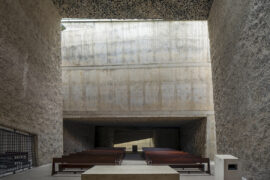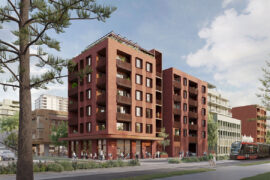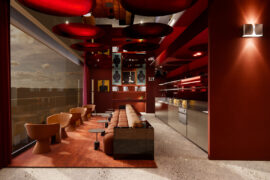The new terminal interiors at the Hamilton Kirikiriroa Airport celebrate the beauty to be found in transition and a connection to the local identity of New Zealand.

May 30th, 2023
Airports are places of transition – between both destinations and between sky and land. It’s this sense that Archimedia Waikato Architects (AWA) wanted to evoke when redesigning Hamilton Kirikiriroa Airport on New Zealand’s North Island. The new interior of the airport, which is run by Waikato Regional Airport Ltd. (WRAL), utilises a dynamic colour palette and natural materials to bring this vision to life. Key to this was the use of Milliken carpet tiles in a bespoke pattern of blues, greens, and greys that appears to change when viewed from the ground and from above – much like the changing perspective you get from a plane.

“The brief was to modernise and reinvigorate the existing terminal, to create a welcoming environment with an enduring local identity,” says Penny Mills, a senior architect at AWA. “The resulting design is about a moment in time and the crossing of paths, fleeting human interactions. It’s about acknowledging the past, being in the present, and looking to the future.”

Essential to this approach is a Cultural Narrative that was developed with the project’s dedicated Cultural Advisor to give the terminal a strong sense of place. This ensured that ideas of Waharoa (gateway), Manaakitanga (care for all), and kotahitanga (unity) were embedded in the design from the outset. “The interior has been imagined as a place for all, somewhere to stop, pause and transition between earth and sky,” explains Mills.


Visitors are welcomed to the airport by a large artwork depicting a manu aute (Māori kite) and a view into the main departure lounge, which is nestled amidst a forest of timber battens on the ceiling and walls. The vaulted plywood ceiling creates an impressive sense of volume, while multi-hued Milliken carpet tiles – in a custom pattern and colour designed specifically for Kirikiriroa Airport – run laterally through the building to guide travellers on their journey.
“The whole of this main concourse is a dialogue between the geometric, repeating rhythm of the ceiling above and the fluid colours and textures of the carpet below,” says Mills. Stronger colours define the areas where visitors congregate, while richly textured grey carpet denotes areas of movement.

The terminal had previously had vinyl flooring on the ground floor. “It was noisy and jarring to walk on, and the reflective surface created a distracting visual glare,” recalls Mills. By upgrading it to Milliken carpet tiles – which absorbs sound and offers a quiet and comfortable surface to walk on through their WellBAC® cushion backing – AWA has transformed the experience of the busy terminal.
The custom pattern and colours combine Milliken’s Clerkenwell and Artistic Liberties collections. “We chose Clerkenwell for its use of geometric pattern,” says Mills. “We liked the use of triangle shapes, the changes in scale, use of tone, the diagonal lines formed through colour position, the thin line effect, and the painterly colour changes. However, we wanted more pattern, texture and ‘grit’ folded into the carpet, which we got by mixing in elements of the Artistic Liberties range.”


On the ground floor, the colours of the carpet respond to Papatuanuku (Earth Mother), with the grey representing Kirikiriroa (a long stretch of gravel) and a pattern that evokes dappled light on a forest floor, while on the mezzanine calming midnight blues and misty greys are symbolic of Ranginui (Sky Father).
The collaboration between AWA and Milliken took place via Zoom during lockdown, and Mills describes it as “open, relaxed, and productive”. The green colourway was particularly difficult to achieve and required multiple samples. “Isabella and Belinda, from the Milliken Design team were very supportive, patient, and professional,” says Mills.

This bespoke colourway and pattern was worth the effort, however, as it underpins the wider Cultural Narrative. “We could specify the colour, pattern and texture for every square of the carpeted floor,” says Mills. “This gave us amazing creative freedom.” In addition, Milliken’s bespoke carpet design offering allows for the printing of additional carpet should WRAL decide to expand into the Northern end of the existing terminal, and the modular nature of the flooring allows for easy replacement of any damaged tiles. Another benefit of using Milliken is the brand’s dedication to sustainability and its ambitious M/PACT™ Carbon Neutral Program, which aligns with WRAL’s goals.
“It was challenging to step out of our comfort zone of using predominantly neutral and grey tones,” reveals Mills. “There can be a fear of working with colour, but we felt that the Cultural Narrative called for it to create a sense of identity and place, to create a space that is recognisable. This was a leap of faith as a designer.”
As a testament to this ‘leap of faith’ the project is a finalist in the New Zealand National ‘Interior Awards – Civic category’, and has also been Shortlisted for an Interior NZIA Award, both to be announced in June.
Milliken
millikenfloors.com.au
AWA Architects
awaarchitects.co.nz
Photography: simonwilson.co.nz

INDESIGN is on instagram
Follow @indesignlive
A searchable and comprehensive guide for specifying leading products and their suppliers
Keep up to date with the latest and greatest from our industry BFF's!

London-based design duo Raw Edges have joined forces with Established & Sons and Tongue & Groove to introduce Wall to Wall – a hand-stained, “living collection” that transforms parquet flooring into a canvas of colour, pattern, and possibility.

The undeniable thread connecting Herman Miller and Knoll’s design legacies across the decades now finds its profound physical embodiment at MillerKnoll’s new Design Yard Archives.

The World Architecture Festival has named The Holy Redeemer Church and Community Centre of Las Chumberas in La Laguna, Spain as World Building of the Year 2025, alongside major winners in interiors, future projects and landscape.

The Minns Labor Government has unveiled nine new architect-designed mid-rise apartment patterns, expanding the NSW Housing Pattern Book and accelerating the delivery of accessible, high-quality housing across the state.
The internet never sleeps! Here's the stuff you might have missed

COX Architecture uses saturated colour and hotel-style amenity across the historic St Peters location, designed for Coronation Property.

The Senior Design Director at RSHP reflects on Barangaroo South Masterplan during a visit to Sydney marking ten years since the completion of the first phase.